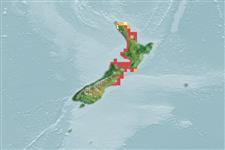>
Ovalentaria/misc (Various families in series Ovalentaria) >
Plesiopidae (Roundheads) > Acanthoclininae
Etymology: Acanthoclinus: Greek, akantha = thorn + Greek, klinein, kline = sloping and bed, due to the four apophyses of sphenoid bone (Ref. 45335).
More on author: Jenyns.
Environment: milieu / climate zone / depth range / distribution range
Ökologie
seewasser; brackwasser demersal; standorttreu; tiefenbereich 0 - 4 m (Ref. 9003). Temperate; 34°S - 44°S, 172°E - 176°E (Ref. 56302)
Southwest Pacific: endemic to New Zealand.
Size / Gewicht / Alter
Maturity: Lm ? range ? - ? cm
Max length : 30.0 cm TL Männchen/unbestimmt; (Ref. 9003); max. veröff. Alter: 9 Jahre (Ref. 9003)
Rückenflossenstacheln (insgesamt): 20; Rückenflossenweichstrahlen (insgesamt): 4; Afterflossenstacheln 9; Afterflossenweichstrahlen: 4
Facultative air-breathing (Ref. 126274); Are residents of intertidal zone with homing behavior (Ref. 32612) found in pools with rocks or boulders. May leave tide pools if aquatic conditions become inhospitable (Ref. 31184). Feed mostly on invertebrates, particularly crustaceans and mollusks. They breathe air when out of water (Ref. 31184) and swim with an eel-like motion (Ref. 9003). Eggs are guarded by the male parent (Ref. 205).
Life cycle and mating behavior
Geschlechtsreife | Fortpflanzung | Ablaichen | Eier | Fecundity | Larven
Nests are constructed beneath boulders where the dense gelatinous cluster of about 10,000 eggs are deposited. The male stands guard and seals the nest from the inside by blocking the entrance with small stones and mud. Eggs hatch after about ten days into planktonic larvae (Ref. 9003).
Paulin, C. and C. Roberts, 1992. The rockpool fishes of New Zealand (Te ika aaria o Aotearoa). Museum of New Zealand (Te Papa Tongarewa). 177 p. (Ref. 9003)
IUCN Rote Liste Status (Ref. 130435)
Bedrohung für Menschen
Harmless
Nutzung durch Menschen
Fischereien: nicht kommerziell
Mehr Information
ReferenzenAquakulturAquakultur ProfilZuchtlinienGenetikElectrophoresesVererbbarkeitKrankheitenVerarbeitungNutrientsMass conversion
PartnerBilderStamps, Coins Misc.LauteCiguateraGeschwindigkeitSchwimmstilKiemenoberflächeOtolithsGehirngrößeSehfähigkeit
Tools
Zusatzinformationen
Download XML
Internet Quellen
Estimates based on models
Preferred temperature (Ref.
123201): 12.3 - 18.4, mean 16.3 °C (based on 64 cells).
Phylogenetic diversity index (Ref.
82804): PD
50 = 0.5312 [Uniqueness, from 0.5 = low to 2.0 = high].
Bayesian length-weight: a=0.00457 (0.00180 - 0.01158), b=3.10 (2.87 - 3.33), in cm total length, based on LWR estimates for this (Sub)family-body shape (Ref.
93245).
Trophic level (Ref.
69278): 3.6 ±0.59 se; based on food items.
Widerstandsfähigkeit (Ref.
120179): mittel, Verdopplung der Population dauert 1,4 - 4,4 Jahre. (tmax=9).
Fishing Vulnerability (Ref.
59153): Low vulnerability (20 of 100).
